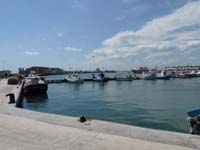A popular coastal town located to the south of Alicante on the Costa Blanca, Spain, Santa Pola has a population of around 30,000 and a municipal area of 58 square kilometres. Possibly visited by Greeks and Phoenicians even before the arrival of the Romans, it later became Portus Ilicitanus under the Romans. Important over the centuries for fishing and salt production, Santa Pola saw the arrival of tourism in the second half of the 20th century, this added with property development saw the town grow in size to its present dimensions. Attracting mostly Spanish holidaymakers, Santa Pola has miles of sandy beaches and a large marina and port, the southern beach areas are especially popular for kitesurfing and windsurfing, with weather conditions ideal for these sports. From the port you can take a boat trip to the nearby island of Tabarca where there are some great opportunities for scuba diving or just simply enjoying the beaches and the sunshine in tranquil conditions. Santa Pola is situated just off the N-332 between Alicante and Guardamar del Segura.
May 10, 2010
April 21, 2010
Silves Algarve Portugal
A town which formerly rivalled Lisbon in prosperity and influence, Silves on the Algarve, Portugal was known as Xelb by the Moors and was their stronghold in the region, having a huge fortress and a population of around 30,000 by the 12th century. Silves was an important trading town with boats arriving via the River Arade and leaving packed with cargoes of citrus fruit, figs and cork, the town was a buzzing community filled with mosques, bazaars and minarets. This all came to an end in 1189, when the town was subjected to a siege by Sancho I together with a band of English crusaders. After holding out for some months, the Moorish occupants finally surrendered due to a lack of water, the town was subsequently sacked and many of its citizens killed. Silves today is a busy town, still important for citrus fruits, figs and cork, but with an emphasis on tourism, its attractive old town, a maze of narrow, cobbled streets dotted with cafés, restaurants and souvenir shops, its castle and a number of its older buildings, survived the 1755 earthquake. Silves Map.
April 17, 2010
Morella Valencia
One of the most distinctive towns in the Valencia region of eastern Spain, Morella is a medieval walled town, overlooked by a 13th century Moorish castle. Its ancient fortified walls are intact and unbroken (save for seven entrance gates), and behind these walls lies a labyrinth of narrow alleyways and streets largely unchanged for centuries. The castle which is now in ruins, dated from the Arab occupation, although the current castle was built upon earlier Iberian and Roman fortifications. Morella has a number of interesting historical monuments and some fine museums.
April 8, 2010
April 5, 2010
Mahon Menorca
The elegant town of Mahon is the capital of the Balearic Island of Menorca, it is renowned for having one of the best natural harbours in the world, this made it an attractive target for the British Navy, who took the town and the island in 1708, and made Mahon their main port in the Mediterranean. Mahon today is a more peaceful place and is an attractive tourist destination, with many places of interest and a great range of facilities, you are more likely to see a luxury yacht in the harbour these days than a warship although it is still a working port. The town enjoys a wonderful climate and the weather in Mahon is pleasant all year round attracting thousands of visitors both during the hot summer months and also during the agreeable winter months. Mahon Map.
March 26, 2010
Mojacar Almeria
Standing on a towering crag overlooking the Mediterranean Sea, the Costa Almeria town of Mojacar is a spectacular sight. Tracing its history back to the times of the Moors, it was actually occupied much earlier with evidence of settlement some 4,000 years ago. During the Arab occupation the town (or village as it was then) was overseen by the Caliphate of Damascus, under his rule it grew in wealth and prosperity. Later joining the Narine sultanate, it became a strategic frontier town facing invading Christian forces from the east. Constant attacks by Christians led to the surrender of the town in 1488, though Moors, Christians and Jews continued to live and trade together. Mojacar fell into decline in the 19th century due to periods of severe drought, returning to prominence in the late 20th century with the arrival of tourism. Visitors attracted by the beauty and charm of this unique place ensure the future of Mojacar as a thriving town, the fine weather conditions make its coastal area, Mojacar Playa, popular as a holiday destination, many have also chosen to purchase holiday homes in Mojacar and there is a good choice of property to pick from if you are thinking of buying in this upcoming area.

